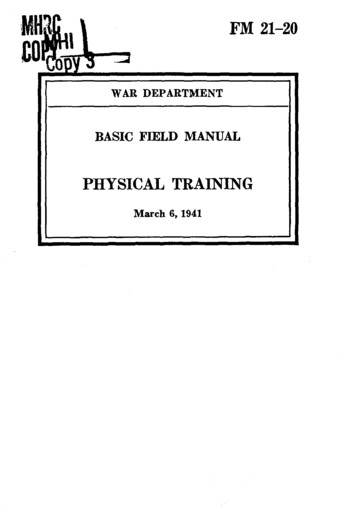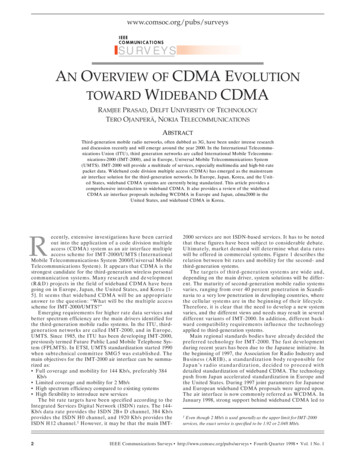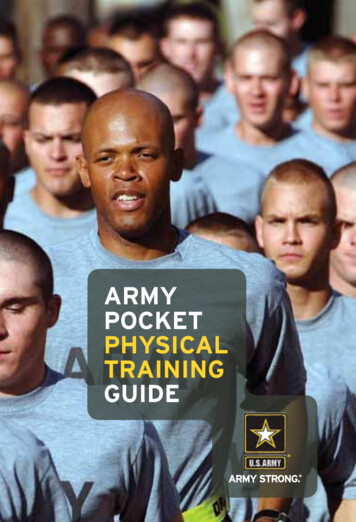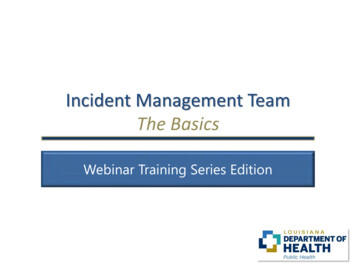
Transcription
iMtFM 21-20:.WAR DEPARTMENTBASIC FIELD MANUALPHYSICAL TRAININGMarch 6, 1941
FM 21-20BASIC FIELD MANUALPHYSICAL TRAININGPrepared under direction of theSuperintendent, United States Military AcademyUNITED STATESGOVERNMENT PRINTING OFFICEWASHINGTON: 1941Forsale by the Superintendent of Documents, Washington. D. C.- Price 30 cent.
WAR DEPARTMENT,WASHINGTON, March 6, 1941.FM 21-20, Basic Field Manual, Physical Training, is published for the information and guidance of all concerned.[A. G. 062.11 (8-31-40).]BY ORDER OF THE SECRETARY OF WAR:G. C. MARSHALL,Chief of Staff.OFFICIAL:E. S. ADAMS,Major General,The Adjutant General.DISTRIBUTION:B (3); R (5); Bn (3), C (10).II
TABLE OF CONTENTSParagraphsCHAPTER 1. GENERAL-- ------ - - - - -CHAPTER 2. CONDUCT OF THE PHYSICAL TRAININGPROGRAM.Section I. General - - --II.Commands-- -- - --Formations, positions, and restsDisciplinary exercises - --Setting-up exercises--Marching and exercises whilemarching- -- .VII. Running, jumping, and climbingVIII. Personal contests . -IX. Mass athletics and group games --CHAPTER 3. MODEL SCHEDULES-CHAPTER 4. RIFLE EXERCISESCHAPTER 5. SWIMMING,LIFESAVINGANDWATERSAFETY.Section I. Swimmning -------.-------II. Lifesaving and water safety- CHAPSER 6. ADVICE TO INsTBRCTORS-- -- --- --CHarTE 7. CATALOG OF EXERCISES, PERSONAL CON.---- --TESTS, AND GROUP GAMES---.-.-----INDEX-- 1·146209
FM 21-20BASIC FIELD MANUALPHYSICAL TRAINING(This manual supersedes ch. 4, BFM, vol. I, March 26, 1936, andTR 115-5, Part II, September 10, 1928.)CHAPTER 1GENERAL1. NEcESrrrYOR PrYSIcAL TRAINING.-TO perform hisduties satisfactorily, the soldier must possess great organicvigor, muscular and nervous strength, endurance, and agility.The average recruit does not possess the degree of physicalfitness required of a trained soldier. The required degreeof physical fitness can be acquired only through physicaltraining. The performance( of purely military exercises,that is, drill, marching, etc., is not alone sufficient to correctthe deficiencies and incorrect postures too often acquiredbefore becoming a soldier. Further, the complexities ofmodern warfare require so much technical training for thesoldier that all too frequently no time is allotted for physicaltraining; yet the soldier who possesses great technical skillbut is unable to withstand the rigorous life demanded is ofquestionable value. Hence, physical training must be anintegral part of every training program. There is no morejustification for failure to allow time in the training programfor physical training on the grounds that the soldier willattain satisfactory physical development through performing his daily duties, than there is for failure to allow timefor training in marksmanship on the grounds that thesoldier will learn to shoot by being taken to the range,issued a weapon and ammunition, and left to his own devices.* 2. PURPOSE.-a. The primary purpose of military physicaltraining is the production of a state of health and generalphysical fitness which will permit the soldier to performthe arduous duties required of him. The ultimate goal ofthis training, then, is physical efficiency which is essentialto military effectiveness. The attainment of physical efficiency through physical training is shown graphically below.
PHYSICAL TRAININGfor MILITARyFIGURE 1.-Chart.b. The disciplinary and setting-up exercises prepare thesoldier mentally and physically for training in such basicskills as marching and running, jumping and vaulting, climbing, crawling, lifting and carrying, and throwing and kicking.Superiority in these basic skills becomes the soldier'simmediate objective and gives him a definite goal for whichto strive. From the effort the soldier puts forward to becomeproficient in these simple skills, he develops endurance andagility. The development of endurance results in health andphysical fitness. The development of agility results in bodycontrol and physical alertness: The soldier is among thefirst to become aware of his own physical development.This knowledge of improvement results in confidence, courage, alertness, initiative, pride, discipline, and posture. Thedevelopment of these many desirable qualities during the2
PHYSICAL TRAINING2-4conduct of the physical training program is a certainty andmay equal, if not surpass, the purely physiological value ofthe training. The final result of all of this training isphysical efficiency, which, as stated before, is an essentialto military effectiveness. (See fig. 1.)E S. RELATIONSHIP BETWEEN PHYSICAL TRAINING AND MILITARYTRAINING.-A man does not become an effective soldier simplyby taking an oath and donning a uniform. The transformation from civilian to soldier is accomplished by training, andit is not complete until the mnan develops those qualitieswhich characterize the trained soldier. The chart (fig. 1)shows at a glance that physical training develops many ofthese desired qualities while making the man physicallyefficient.* 4. PHYSICAL TRAINING PROGRAM.-a. Scope.-The physicaltraining program described in this manual is composed ofseveral different activities, each having a special purpose.The activities may be conducted either without the aid ofequipment or with the aid of such as may be improvised.These activities are(1) Disciplinary exercises.(2) Setting-up exercises.(3) Marching and exercises while marching.(4) Running, jumping, and climbing.(5) Personal contests.(6) Mass athletics and group games.(7) Rifle exercises.(8) Swimming.b. Description and purpose.-(1) Disciplinary exercises.These embrace the positions of attention, rests, facings, handsalute, mark time and halt, and the starting positions forsetting-up exercises. These exercises must be executed withsnap and precision. They are given at the very beginningof the daily morning period in physical training and aredesigned to give the instructor complete control over his unitas well as to alert the men for the work to follow.(2) Setting-up exercises.-These exercises are for all partsof the body-arms, neck, shoulders, trunk, and legs. All areemployed in each lesson in the harmonious development ofS
4PHYSICAL TRAININGthe entire body. They serve not only to develop all parts ofthe body, but also as a warn-up to prepare the soldier forthe more strenuous exercises which follow immediately after.Properly executed, they also have an educational and disciplinary value which is equal, if not superior, to the purelyphysiological benefits.(3) Marching and exercises while marching.-These exercises consist of marching in quick or double time, and suchexercises as can be performed while marching. They aredesigned to develop poise, posture, coordination, control,suppleness, and endurance.(4) Running, jumping, climbing, and crawling.-Thisphaseof the physical training program consists of work on theobstacle course (see par. 32), or, if no obstacle coarse is available, in traversing rough and varied terrain. It is designedto develop endurance, agility, and coordination, as well as totrain the soldier to overcome such obstacles as may confronthim during field service.(5) Personal contests.-Personal contests are the simplerforms of competitive gymnastics, where the participants arepitted against each other. Such contests never fail to produce rivalry for superiority. Their chief value lies in thedevelopment of agility and quickness of thought and action.(6) Mass athletics and group games.-Mass athletics andgroup games are those forms of competitive or recreationalsports which can be indulged in by all the men of a unit.They develop mental and physical alertness, coordination,and unit or group spirit, and give variety and interest to thephysical training program.(7) Rifle exercises.-Rifle exercises are in reality setting-upexercises with the rifle as equipment. Owing to the weightof the rifle, these exercises are useful for the development ofthe muscles of the arms, upper back, shoulders, and chest,and, when taken in conjunction with trunk and leg exercisesthey are excellent agents for the all-around development ofthose who possess the strength to wield the piece toadvantage.(8) 1Swimming.--Swimrning is of importance to everyoneconnected with the service, and all officers and enlisted menshould become proficient. in it. Aside from its usefulness, it4
4-5PHYSICAL TRAININGis an excellent means to all-around physical development.(9) Activities requiring special equipment.-Activities requiring special equipment are not included in this manual.Activities of this type are(a) Gymnastics.-This includes exercises utilizing thehorse, parallel bars, horizontal bar, rope, etc. The chiefobject of this instruction should be the development of theability of the soldier to control his body while his weight issupported by or suspended from the arms and hands, thusenabling him to overcome such obstacles as may presentthemselves during field service. These exercises will tend tomake the soldier agile and active and will teach him decisionand self-reliance.(b) Boxing and wrestling.-Boxing and wrestling developendurance, agility, and strength, and are important factorsin the development of confidence, courage, and self-control.E 5. STANDARDS AND TESTS.---a. Standards.-Asstated in paragraph 11, the physical training program should be based uponthe condition and aptitude of the men to be trained. Thebest method of determining this condition and aptitude ofthe group is by comparison with known standards.(1) The following table of standards may be used as aguide for men in field uniform:MinimumstandardEvent100-yard dash---Running highjump.Running broadjump.Push-up fromground.(2)(a)(b)(c)(d)mAverageAbove averageSuperior14 seconds----3 feet 9 inehes13 seconds.---4 feet -.-------12% seconds-.4 feet 3 inches123 seconds.4 feet 6 inches.12feet.13feet inches15feet.---16 feet 6 inches.20---25 .-----------. .-.30.35.Other minimum standards for average men areBaseball throw-125 feet.Basketball throw---60 feet.Bar or fence vault-4 feet.Run a quarter mile--87 seconds.5
546PHYSICAL TRAINING(e) Run a half mile--3 minutes 15 seconds.(f) Walk 2 miles-23 minutes 30 seconds.(g) Jump and reach-13 inches.1. From a position with the feet close together andheels and toes on the ground, the man stretchesboth arms overhead, fingers extended. Measurethis height.2. He then jumps vertically, reaching as high as pos'sible. Measure this height.3. The difference between the heights in I and 2 abovegives the "jump and reach" distance.(h) Pull-up (chin)-6 times.(i) Climb 20-foot rope-20 seconds.(j) Standing hop, step and jump-18 feet.(k) Running hop, step and jump-22 feet.(Z) Standing broad jump-6 feet.(m) Standing backward jump-2 feet 8 inches.(n) Running long dive-5 feet 6 inches:b. Tests.-(1) The only way a comparison can be madebetween a standard to be reached and the ability of an individual or group is by tests. Tests have a very important placein any physical training program. They give the soldier anopportunity to compare his ability with that of others and,consequently, are of tremendous value in stimulating hisinterest and his effort. Tests serve the instructor as a meansof measuring the progress of his men and the efficiency ofhis instruction. They also serve to point out to the instructorspecific needs or deficiencies of individual men which require special instruction or corrective work.(2) Tests can be conducted with little, if any, interferencewith the scheduled program, and require nothing more thana little planning on the part of the instructor. Their valueto the program is so great that they should be held at regularintervals.* 6. ALLOTMETT OF TINE FOR PHYSICAL TRAINING.-The timeallotted to physical training for recruits should, when thetraining schedule permits, consists of 11/2 hours each day. Onthe other hand, technical and tactical training requirementsas approved in Mobilization Training Programs must be met,6
PHYSICAL TRAINING6and the desired 11/2 hours of physical training daily may haveto be reduced. It is the task of the commander concernedto utilize to maximum advantage, the time available forphysical training. A brief description of how a daily l1/2-hourphysical training period may be successfully employed is givenin a and b below.a. Morning period.-(1) The morning period should beginnot earlier than 1 hour after breakfast and should last atleast 30 minutes. Men should not be required to indulge instrenuous exercises before breakfast. Exercises before breakfast are not recommended; if indulged in at all, they shouldbe confined to a few arm stretchings and relaxed trunk-bending exercises--just exertion enough to accelerate circulationmildly. To exercise strenuously before breakfast is likely toaffect the digestive operation seriously, and is more apt toweaken than to strengthen the body, which is at a very lowstate of physical efficiency immediately after arising, whenits resistance is low. It has been shown that the body doesnot regain its normal state of physical efficiency until wellafter breakfast and that it reaches its highest peak of efficiency in the middle of the afternoon.(2) The morning period should embrace the following formsof exercise in the order named:(a) Disciplinary exercises, 2 or 3 minutes.(b) Setting-up exercises, 12 to 15 minutes.(c) Marching and exercises while marching, 3 to 5 minutes.(d) Running, jumping, climbing, etc. (work on the obstacle course),%8 to 10 minutes.(e) If more than 30 minutes are available, add personalcontests.(f) At times it is desirable to substitute personal contestsand group games for (c) and (d) above, even though only 30minutes are available for the period.b. Afternoon period.-The afternoon period should beclosely supervised but should be primarily recreational. Itshould be devoted to conducting tests, mass athletics, andgroup games. Where facilities exist for swimming, gymnastics, boxing, and wrestling, such instruction should be givenat this time.7
7-8PHYSICAL TRAININGU 7. UNIFORM TO BE WORN.---a. The uniform worn will dependupon the season of the year and the state of the weather.At no time should a uniform be worn which does not admitof the freest possible movement of the body.b. Undershirts, slacks, or loosely laced breeches without leggins, and regulation shoes comprise the usual uniform duringthe summer months; olive-drab shirts are usually prescribedduring cold or inclement weather. Hats, caps, or blousesshould not be worn.U 8. ELEMENTARY RuLES FOR HEALTH.-a. Health is that quality of the entire body, including the mind, which renders thesoldier capable of developing to the highest degree of efficiency. Good health, denoting a vigorous body, alert mind,and high morale, is evidenced by the degree in which it expresses itself in a well-disciplined, proud, confident, andcapable soldier. Physical health cannot be separated frommental health. Ill health is quite as often due to conditionsof the mind resulting in bodily ailment as due to purelyphysical causes. Therefore, in giving rules for health, it isessential that mental hygiene as well as physical hygiene beconsidered.b. A healthy state of mind is characterized by cheerfulness,confidence, and interest. An unhealthy state of mind ischaracterized by indifference, discouragement, worry, and afeeling. of inferiority due to lack of success or progress. Muchcan be done through physical training to develop in the mena healthy mental state. This may be accomplished by(1) Instructor being a worthy example to the men.(2) A fair, impartial, understanding attitude on the part ofthe instructor.(3) Work being interesting and varied.(4) Work being arranged so as to result in progressivedevelopment.c. The importance of proper personal habits, such as cleanliness, proper eating, rest, and elimination, should be stressedto the men during instruction in physical training.d. Physical training should not be scheduled immediatelyafter reveille or immediately before or after meals (see par. 6).e. Clothing suitable for exercise should be prescribed(par. 7).8
PHYSICAL TRAINING8-9J. Men should be "warmed up" gradually before engagingin strenuous exercise.g. Muscular action produces an unusual amount of bodilyheat which should be lost gradually, otherwise the body will bechilled. Hence, after exercise, never remove clothing to cooloff, but, on the contrary, wear some additional clothing. Ifno additional clothing is available, men should be kept mildlyactive allowing the body to cool gradually.h. Drinking water, particularly cold water, during or immediately after exercise should be discouraged; the bodyshould be allowed to recover its normal condition beforequenching the thirst with draughts of cold water. If necessary to do so while exercising, cool, not cold, water may beused in small quantities, but exercise must continue, especially if the body is in a state of perspiration.* 9. POSTURE.-a. Definition.-(1) Posture may be definedas the bearing of a person. It is determined by the relativearrangement of the parts of the body, and hence may bewhatever one wishes it to be, unless some structural defectprevents. Even in such cases, proper exercise and effort maymaterially assist in overcoming or modifying defects. Usually, however, defective posture is due to carelessness orignorance and not to structural causes.(2) The position of the spinal column, which runs fromthe head to the pelvic region, is the cause of most defects inposture. Such defects as poor head carriage, humped-upshoulders with resulting hollow chests, sway backs and protruding stomachs and buttocks can be attributed to a faultyposition of the spinal column.b. Promoting good posture.-(1) The gaining of goodposture depends upon the efforts of the individual soldier. Itdepends upon his desire, pride, attitude, and alertness, hisconstant thinking of his own bearing; this will tend finallyto change his usual bodily carriage. Exercises for correctingposture serve to build a healthy condition of the muscles withbetter muscle tone, but this is merely one of the prerequisitesfor the promotion of posture improvement.(2) The best commands to promote and encourage goodposture will be similar to the following: STAND TALL, WALK9
9PHYSICAL TRAININGTALL, RELAX YOUR MUSCLES AND STAND TALL, THINK OF YOURHEAD AS PULLING YOUR BODY UPWARD.The desire must beinstilled into the soldier as well as constant attention beingdirected to his carriage. The points for the physical instructor to consider and emphasize are(a) A desire in the individual for good posture.(b) Very frequent thought on the part of the individualto maintain good posture.(c) Sufficient strength and muscle tone.(d) A body sense of the feeling of good posture.(e) Pride in one's self and one's organization.(f) A confident and optimistic attitude.c. Value of good posture.-(1) In a well-poised body, theinternal organs are held in a position best suited to theproper performance of their functions, By the eliminationof a crowded and sagging position, abdominal pressure of theorgans is removed. Circulation, digestion, elimination, glandular secretion, and all the processes vital to health are aided.Strain on the nerves and the vessels leading to the abdominalorgans, which causes lack of sufficient vitality in the internaltissues, is remedied.(2) Aside from the physiological values of correct posture,a well-poised soldier is more impressive, gains more confldence, and is more effective than he otherwise would be.10
CHAPTER 2CONDUCT OF THE PHYSICAL TRAINING TION I. General14-17-----II. Commands ------------------------18-21- ------Ill. Formations, positions, and rests --- -22-23IV. Disciplinary exercises ----- ------ ---24-27-------------------------V. Setting-up exercises28-30VI. Marching and exercises while marching --------31-33VII. Running, Jumping, and climbing- - ----- ---------------34-365VI. Personal contests36-38IX. Mass athletics and group games ---- - --- SECTION IGENERALm 10. INSTRmcTomR-a. Quaihfications.-The instructor mustrealize the necessity of physical training and understand itspurpose. He should be of better than average physique, readyand able to demonstrate personally what is required of themen, and possess those qualities of leadership which will bringout the best efforts of the men being trained. He must prepare himself thoroughly for conducting each day's work ifhis instruction is to get the results intended. The success orfailure of a program-in physical training depends upon hisability and enthusiasm more than upon any other one thing.The importance of the instructor cannot be overemphasized.b. Attitude.-The attitude of the instructor to the work inphysical training will determine the results attained by it.A lack of enthusiasm on the part of the instructor will beapparent to the men immediately, and the period will be justso many minutes of time wasted. The instructor must bepatient and reasonable. He should commend good performance as quickly as he censures bad. He should require all mento give their best efforts, and he should, by his attitude, inspirehis men to do their best. He must be able to distinguish between poor performance caused by lack of ability or aptitudeon the part of the soldier and poor performance caused by11
10-13PHYSICAL TRAININGlack of effort. lie should treat the first with patience andunderstanding and the latter with firmness; he must neveremploy sarcasm or ridicule.c. Advice to instructors.-See chapter 6.U 11. CoNDITIONAND APTITUDE OF THE MEN.-The conditionand aptitude of the men should always determine the natureand extent of the task expected of them. The instructormust so organize the work as to condition the men gradually.Too often an over-zealous instructor mistakes quantity forquality, with the result that the men undergoing trainingbecome sore and stiff, and look upon the next period of instruction with apprehension. Since the work for the recruitis not satisfactory for the trained soldier, the instructor mustgive deep consideration to the condition and aptitude of hismen and plan his work accordingly. The benefits of thistraining cannot be recognized in a day, but a course progressively arranged will so condition the men and increasetheir aptitude that they will reach the standard requiredwithout any ill effects.* 12. SIZE OF THE CLASS-AS a rule for most efficient instruction, the class should be limited in size to the platoon.This size class permits of maximum control by the instructorand results in efficient and thorough instruction. For disciplinary purposes and for welding the command into a compact, alert, and spirited unit, occasionally whole companies,or even battalions and regiments, should be drilled as a unit.13. ARRANGEMENT OF THE LEssoN.--a. Balanced lessons.(1) The necessity for balanced lessons cannot be overemphasized. If the maximum benefit is to be derived fromn thephysical training program, the ultimate aim or purpose mustbe kept in mind and the work organized so as to include asmany as possible of the basic skills required of the soldier.This is especially true of the morning period. This period isthe foundation of the entire program and must be arrangedto include instruction which will result in the soldier developing in discipline, endurance, agility, good posture, body control, and health.(2)· There is no doubt but that setting-up exercises are ofgreat value in developing discipline, coordination, alertness,12[
PHYSICAL TRAINING13-14muscle tone, and posture: however, endurance and agilitycannot be developed by setting-up exercises alone. The setting-up exercises must be supplemented by contests and suchexercises as running, jumping, climbing, crawling, vaulting,and dodging. It is realized that all of the activities listedabove cannot be included in one morning period of 30 minutes; however, they can and should be alternated so thatthe physical training instruction results in well roundeddevelopment. See paragraph 6 for a guide in arranging thisperiod.(3) Since the primary purpose of the afternoon period isrecreational, the principal requirement for this period, isinterest.b. Interest factor.-Physicaltraining instruction should bemade as interesting as possible, so that it will react as anexhilarant and awaken the enthusiasm of the men. Thisenthusiasm will not result, however, if the mind is not employed as well as the body. This work, therefore, should beso conducted as to appeal to the mental, as well as the physical, side of the men. By appealing to their intelligence, acheerful, intelligent, and enthusiastic responsiveness alwaysresults. An officer who does not grasp this fact will find himself unable to arouse the men to the point where they willvoluntarily extend themselves to the limit of their capabilities. No stone must be left unturned in an effort to make thework interesting. The use of tests and competitions will assistgreatly in securing this result.SECTION IICOMMANDSU 14. GnERAL.-a. Definition of commands. Commandsare the means through which an instructor orally communicates what is required of those in his charge, and when thisrequirement is to go into effect.b. Use of commands.-The importance of proper commands in conducting the physical training program cannotbe overestimated. The proper execution of disciplinary exercises, setting-up exercises, marching, and exercises whilemarching is so dependent upon the proper use of commands 453898 -41132
14-15PHYSICAL TRAININGthat the instructor must be thoroughly familiar with theproper commands and accomplished in their use. Thisknowledge and ability will be of great assistance in conducting all other phases of the program. Invariably theperformance is the direct reflection of the command callingfor it. When a command is given distinctly, concisely, withenergy and snap, and with proper regard to rhythm, theperformance will be found to fit the command; whereas alifeless, slovenly, and disorganized performance will resultfrom a careless and indifferent command.* 15. TYPE AND DEVELOPMENT OF VOICE FOR GIVING COM-MANDs.-a. General.-Officers should, by constant practice,develop their vocal powers until they develop a commanding voice with the requisite amount of "carry" and quality,and with proper pitch. Every individual's voice will carryfarther if pitched in a certain key. Officers should makeit their business to find out what key that is and develop it.b. Chest voice.-(1) Commands should be delivered withwhat is commonly known as a "chest voice" in contradistinction to what is known as a "head or nasal voice."The former is usually a low-pitched voice that will carryfarther, be more distinct, and require very much less effortthan the latter.(2) In order to cultivate the chest voice, the muscles ofthe chest, neck, and those that control the larynx shouldbe relaxed in order to enable the trachea or windpipe to befully distended when the air is being forced up through itand against the vocal cords by the action of the diaphragm.(3) The mouth should be opened fully and, with the as-sistance of the proper use of the tongue, teeth, and lips,the words of the command should be articulated and enunciated distinctly and precisely and with sufficient volume tofit the occasion.c. Exercises for voice.-The following simple exercises arerecommended to cultivate these qualities:(1) Take a moderately deep inhalation and then, followingthe instruction given in b(3) above, utter the word "hong"moderately loud and in the proper pitch for 3 or 4 seconds;inhale again and repeat the process, uttering the word"kong."14
PHYSICAL TRAINING15-16(2) The volume should be gradually increased and variation given to the exercise by substituting the words "singsong" and "ding-dong." These words are recommended because they are simple, easily remembered, and because thesounds required in uttering them adapt themselves best inbringing out the intent of the instruction.d. Articulation and enunciation.-All the words of a command, particularly of the preparatory or explanatory command, must be articulated distinctly. The enunciation mustbe clear, have the proper intonation, possess the proper inflection and power, and be convincing. The diction must bepure; the substitution of sounds, which in many instanceshave no relation whatever to the sounds of the words forwhich they are substituted, should be avoided.U 16. KINDs OF CoMrAND-s.--a. Preparatory commands andcommands of execution.-There are two kinds of militarycommands, the preparatory, and the command of execution.The preparatory command describes and specifies what is required and the command of execution calls into action whathas been prescribed. All preparatory commands must be givenwith a rising inflection, the instructor having the feeling thathe is lifting the entire command with his voice and creatingan eagerness on the part of the men to be off when the command of execution is practically shot at them.b. Commands for static exercises.-(1) Static exercises arethose in which a position is held for an appreciable length oftime. If it is the purpose of the instructor to have anyexercise performed in this manner, he will use words ratherthan numerals to indicate the successive movements. Thus:1. ON TOES, 2. RISE, 3. KNEES, 4. BEND, 5. KNEES, 6. EXTEND,7. HEELS, 8. DOWN, or, 1. TRUNK FORWARD, 2. BEND, 3.RECOVER.(2) In these commands, the command of execution mustindicate how the movement is to be performed.(3) In the first of these exercises the command RISE isgiven sharply and snappily, indicating that a snappy performance is wanted; the command BEND is drawn out moderately, to indicate moderately slow performance; the command EXTEND is also give
training program described in this manual is composed of several different activities, each having a special purpose. . Boxing and wrestling.-Boxing and wrestling develop endurance, agility, and strength, and are important factors in the devel





